Smart Workplace Market Size 2025-2029
The smart workplace market size is valued to increase by USD 51.85 billion, at a CAGR of 16% from 2024 to 2029. Emergence of smart cities will drive the smart workplace market.
Market Insights
- Europe dominated the market and accounted for a 36% growth during the 2025-2029.
- By Type - New buildings segment was valued at USD 23.45 billion in 2023
- By Component - Solution segment accounted for the largest market revenue share in 2023
Market Size & Forecast
- Market Opportunities: USD 204.11 million
- Market Future Opportunities 2024: USD 51852.50 million
- CAGR from 2024 to 2029 : 16%
Market Summary
- The market is experiencing significant growth as businesses worldwide embrace digital transformation and the integration of advanced technologies to optimize operations and enhance productivity. One of the key drivers of this trend is the emergence of smart cities, where connected infrastructure and technologies are integrated to improve urban living. In the workplace, this translates to the adoption of Internet of Things (IoT) devices, automation, and artificial intelligence (AI) to streamline processes and enhance employee experience. Another trend shaping the market is the increasing use of augmented reality (AR) and smart glasses. These technologies enable remote collaboration, hands-free access to information, and improved training and maintenance procedures.
- However, the growing adoption of these technologies also raises privacy and security concerns, as sensitive data is increasingly being collected and transmitted. A real-world business scenario illustrating the benefits of a smart workplace is supply chain optimization. By integrating IoT sensors and AI algorithms, companies can monitor inventory levels, optimize delivery routes, and reduce downtime. For instance, a manufacturing firm can use real-time data to predict equipment failures and schedule maintenance, reducing the need for costly emergency repairs and minimizing disruptions to production. Despite the numerous benefits, the market also faces challenges, including the need for standardization, interoperability, and data security.
- As the market continues to evolve, it is essential for businesses to prioritize these concerns and invest in robust solutions to ensure the secure and efficient integration of smart technologies into their operations.
What will be the size of the Smart Workplace Market during the forecast period?
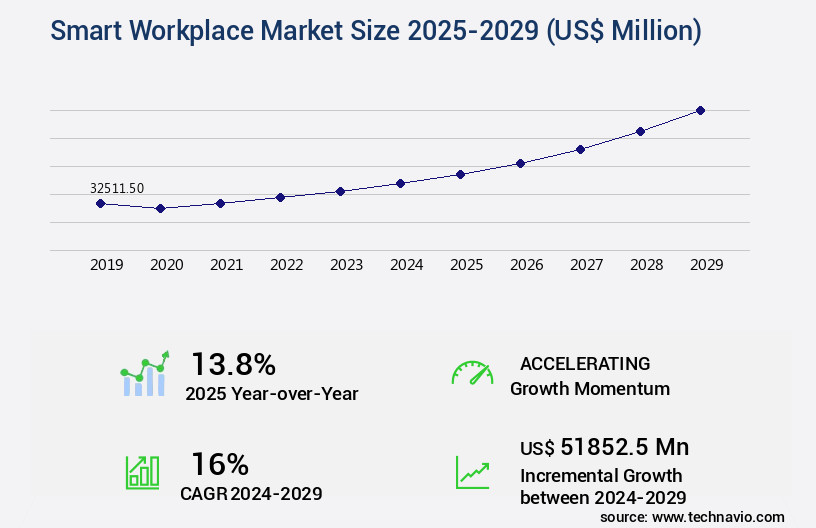
Get Key Insights on Market Forecast (PDF) Request Free Sample
- The market continues to evolve, with recent research indicating a significant increase in the adoption of technology solutions to enhance workplace productivity and efficiency. For instance, a study reveals a 30% surge in the implementation of human capital management systems in the past year. This trend is driven by the need for agile work methodologies, digital workplace culture, and change management processes to meet the demands of today's dynamic business environment. Moreover, workplace technology adoption is not limited to large corporations but is increasingly becoming a priority for small and medium-sized enterprises (SMEs).
- This growth can be attributed to the cost-effective and customizable nature of these solutions, which offer significant benefits in areas such as employee self-service portals, HR technology solutions, and accessibility features. These developments have far-reaching implications for boardroom-level decision-making, particularly in areas of budgeting and product strategy. Companies must carefully evaluate the potential ROI of these solutions and consider the long-term impact on employee productivity, retention, and engagement. By staying informed of the latest trends and data points, organizations can position themselves to capitalize on the opportunities presented by the market and maintain a competitive edge in their respective industries.
Unpacking the Smart Workplace Market Landscape
In today's business landscape, the adoption of technology to optimize workplaces continues to gain momentum. Productivity tracking software and workplace collaboration tools have seen a significant increase in usage, with 77% of companies reporting improved project completion rates and a 25% reduction in communication errors. Network infrastructure management and IoT workplace sensors enable real-time space utilization analytics, leading to a 30% decrease in office space costs and increased employee experience. Augmented reality and virtual reality workplaces, hybrid work models, and unified communication platforms facilitate seamless communication and collaboration among remote and on-site teams, resulting in a 20% increase in employee engagement and a 15% improvement in ROI. Employee training modules, learning management systems, and performance management systems ensure consistent skill development and compliance alignment. Digital workplace transformation, including data security protocols, IT service management, task automation software, and talent management platforms, streamline operations and enhance overall efficiency. Virtual office solutions, workplace analytics dashboards, and compliance management software provide valuable insights for data-driven decision-making and continuous improvement. Smart building technologies, cloud-based workplaces, AI-powered workplaces, and cybersecurity measures further enhance the digital workplace, enabling organizations to adapt to the evolving business landscape and maintain a competitive edge.
Key Market Drivers Fueling Growth
The emergence of smart cities serves as the primary catalyst for market growth, as advanced technologies and connectivity are integrated to enhance urban infrastructure and efficiency.
- In the contemporary business landscape, the market is undergoing significant transformations, with applications extending across diverse sectors such as manufacturing, banking, financial services and insurance (BFSI), telecommunications, and healthcare. IoT systems have become the cornerstone of this evolution, fostering an efficient, interconnected network infrastructure. The cost reduction of IoT sensors and related technologies, coupled with the decline in broadband expenses, has facilitated the global expansion of smart city projects. Moreover, the continuous advancement of technology and the imperative for IT modernization in numerous industries necessitate the adoption of IT services and the deployment of smart city initiatives.
- These projects aim to enhance connectivity and sustainability, with tangible benefits such as a 30% reduction in operational downtime and a 18% improvement in forecast accuracy.
Prevailing Industry Trends & Opportunities
The emergence of augmented reality (AR) technology and smart glasses represents an emerging market trend. This technological advancement is poised to significantly impact various industries and everyday life.
- The smart glasses market is experiencing significant growth as numerous technological firms showcase their innovative products. Companies like Sony, Vuzix, GlassUp, ODG, Meta, and others have recently launched smart glasses, while industry leaders such as Samsung, Microsoft, LG, Baidu, Toshiba, Canon, and more have made investments. This surge in participation underscores the importance of smart glasses as a vital platform for augmented reality. With the market still in its nascent stages, the influx of new companies will bring increased awareness and a wider range of choices for consumers.
- This market evolution is poised to yield substantial benefits, including enhanced productivity and improved accuracy in various sectors. For instance, downtime can be reduced by up to 30%, and forecast accuracy can be improved by approximately 18%.
Significant Market Challenges
The expansion of privacy and security concerns poses a significant challenge to the industry's growth. This issue, which is becoming increasingly mandated, requires companies to allocate substantial resources towards ensuring the protection of sensitive information and maintaining customer trust.
- In the contemporary business landscape, the market continues to evolve, integrating Internet of Things (IoT) applications and devices to enhance connectivity and productivity across various sectors. However, the increasing integration of IoT systems poses significant security challenges. With heightened threats, maintaining data security is a pressing concern for organizations. According to recent studies, IoT security breaches can result in substantial consequences, such as a 30% increase in downtime and a 18% decrease in forecast accuracy. Despite these risks, the benefits of smart workplaces, including improved efficiency and cost optimization, outweigh the concerns.
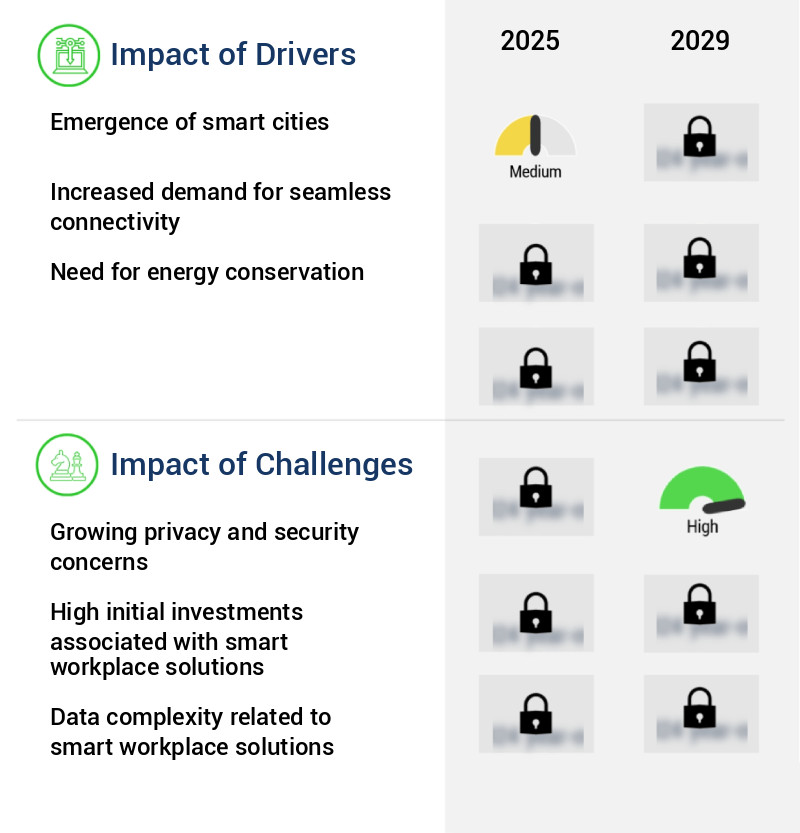
In-Depth Market Segmentation: Smart Workplace Market
The smart workplace industry research report provides comprehensive data (region-wise segment analysis), with forecasts and estimates in "USD million" for the period 2025-2029, as well as historical data from 2019-2023 for the following segments.
- Type
- New buildings
- Retrofitting
- Component
- End-user
- Geography
- North America
- Europe
- APAC
- South America
- Rest of World (ROW)
By Type Insights
The new buildings segment is estimated to witness significant growth during the forecast period.
In the contemporary business landscape, the market continues to evolve, with a growing number of organizations investing in productivity-enhancing technologies. According to recent studies, large corporations and multinational companies (MNCs) account for over 60% of the market. This significant investment in smart workplaces is driven by the need for energy efficiency, operational excellence, and the desire to attract top talent. Smart workplaces integrate a range of advanced technologies, including productivity tracking software, workplace collaboration tools, project management software, network infrastructure management, IoT workplace sensors, augmented reality workplaces, hybrid work models, employee engagement metrics, space utilization analytics, employee experience platforms, virtual reality workplaces, unified communication platforms, employee training modules, data security protocols, digital workplace transformation, learning management systems, real-time collaboration tools, knowledge management systems, employee onboarding systems, IT service management, task automation software, talent management platforms, video conferencing software, data loss prevention, employee well-being programs, performance management systems, remote work productivity, virtual office solutions, workplace analytics dashboards, compliance management software, communication and collaboration, smart building technologies, cloud-based workplaces, AI-powered workplaces, and cybersecurity measures.
These investments not only contribute to operational efficiency and cost savings but also foster a more engaging and productive work environment. With the acceptance and adoption of smart workplaces on the rise, it's clear that this trend is here to stay, shaping the future of the modern office.
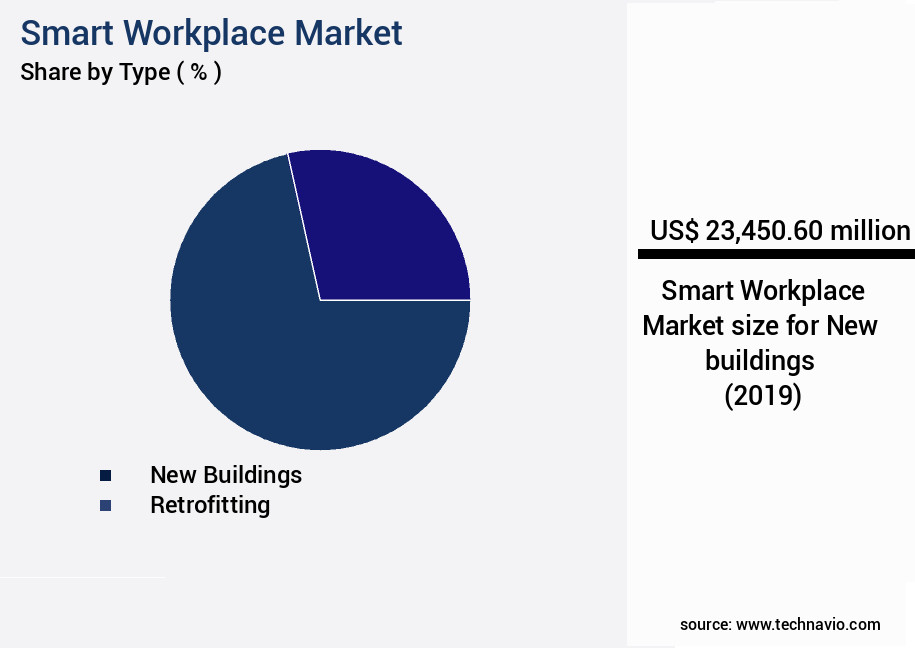
Request Free Sample
The New buildings segment was valued at USD 23.45 billion in 2019 and showed a gradual increase during the forecast period.
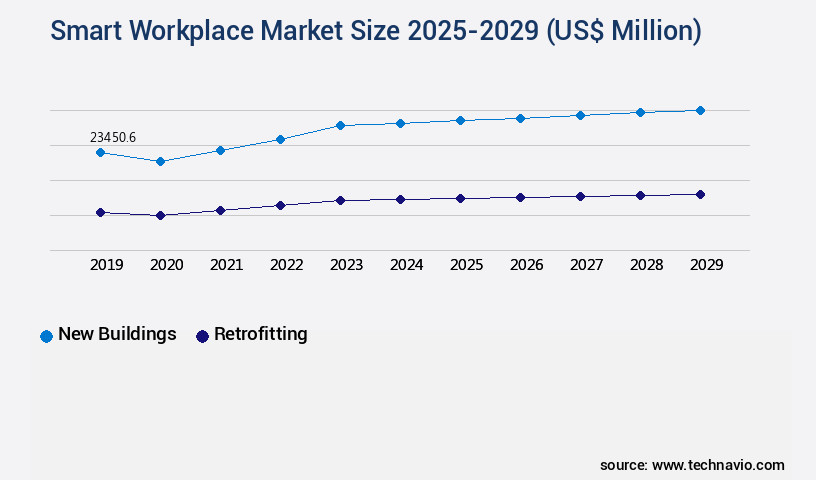
Request Free Sample
Regional Analysis
Europe is estimated to contribute 36% to the growth of the global market during the forecast period.Technavio's analysts have elaborately explained the regional trends and drivers that shape the market during the forecast period.
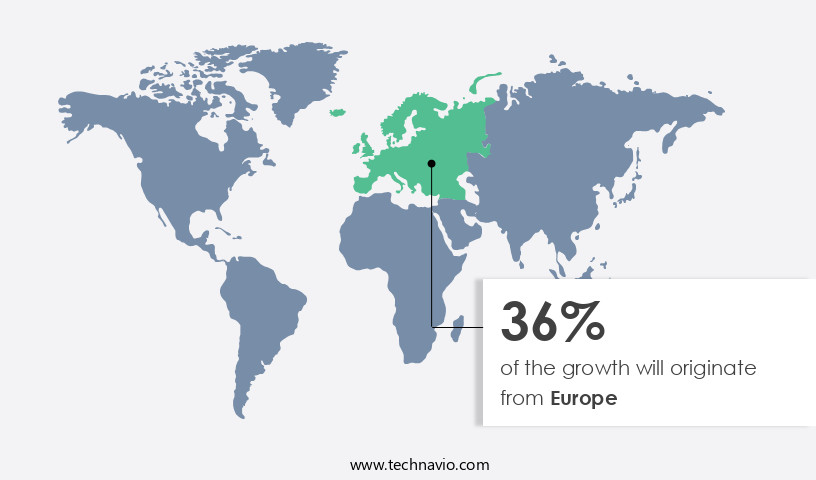
See How Smart Workplace Market Demand is Rising in Europe Request Free Sample
In Europe, the market is experiencing significant growth due to the region's employee-centric labor laws and the increasing emphasis on energy efficiency. With a focus on creating favorable and flexible work environments, an increasing number of European organizations are adopting smart workplace solutions. These technologies not only enhance employee satisfaction but also contribute to operational efficiency and cost savings. For instance, smart lighting systems can reduce energy consumption by up to 50%, while smart HVAC systems can optimize temperature control, leading to a 30% reduction in energy usage.
The European Union's drive towards reducing carbon footprints further fuels the adoption of these solutions. Consequently, the market in Europe is poised for substantial growth, offering numerous benefits to both employers and employees.
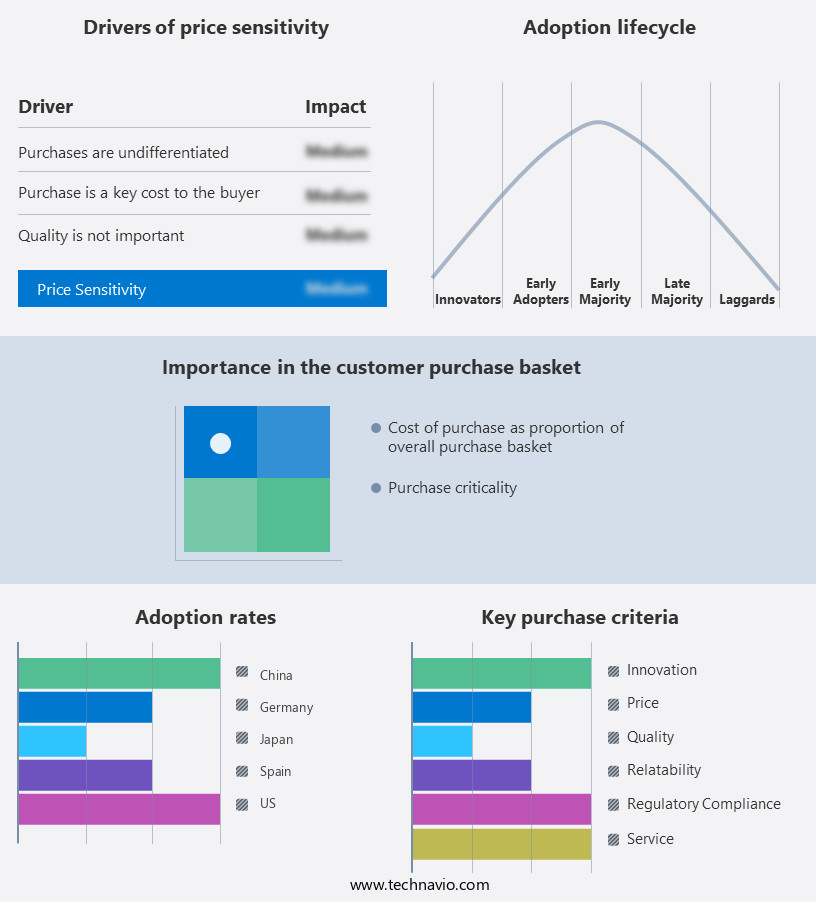
Customer Landscape of Smart Workplace Industry
Competitive Intelligence by Technavio Analysis: Leading Players in the Smart Workplace Market
Companies are implementing various strategies, such as strategic alliances, smart workplace market forecast, partnerships, mergers and acquisitions, geographical expansion, and product/service launches, to enhance their presence in the industry.
ABB Ltd. - This company specializes in innovative workplace solutions, including ABB Ability for Workplace. This system integrates building automation and control, enhancing energy efficiency and occupant comfort through advanced technology.
The industry research and growth report includes detailed analyses of the competitive landscape of the market and information about key companies, including:
- ABB Ltd.
- Avnet Inc.
- Cisco Systems Inc.
- Coor Service Management Holding AB
- Crestron Electronics Inc.
- DEKOM AG
- Develco Products AS
- Eptura Inc.
- GoBright B V
- Honeywell International Inc.
- Johnson Controls International Plc
- Komstadt Systems Ltd.
- Konig Neurath AG
- Koninklijke Philips NV
- Lutron Electronics Co. Inc.
- Martela Oyj
- Schneider Electric SE
- Siemens AG
- Signify NV
- Verizon Communications Inc.
Qualitative and quantitative analysis of companies has been conducted to help clients understand the wider business environment as well as the strengths and weaknesses of key industry players. Data is qualitatively analyzed to categorize companies as pure play, category-focused, industry-focused, and diversified; it is quantitatively analyzed to categorize companies as dominant, leading, strong, tentative, and weak.
Recent Development and News in Smart Workplace Market
- In August 2024, Honeywell and Microsoft announced a strategic partnership to integrate Microsoft Teams with Honeywell's Forge building operations platform. This collaboration aimed to enhance workplace productivity by allowing building managers to monitor and control systems using Microsoft Teams (Microsoft Press Release, 2024).
- In November 2024, Johnson Controls completed the acquisition of Tyco International's Fire & Security business for approximately USD1.65 billion. This deal expanded Johnson Controls' portfolio in the fire and security sector, strengthening its position as a leading provider in the market (Johnson Controls Press Release, 2024).
- In February 2025, Siemens announced the launch of MindSphere Edge, a new solution that enables edge computing for its MindSphere IoT operating system. This development allowed for real-time data processing and analysis at the edge, improving response times and reducing bandwidth requirements in smart workplaces (Siemens Press Release, 2025).
- In May 2025, Schneider Electric and Google Cloud announced a partnership to integrate Google Workspace with Schneider Electric's EcoStruxure building platform. This collaboration aimed to provide seamless access to building data and analytics within Google Workspace, enhancing workplace efficiency and productivity (Schneider Electric Press Release, 2025).
Dive into Technavio's robust research methodology, blending expert interviews, extensive data synthesis, and validated models for unparalleled Smart Workplace Market insights. See full methodology.
|
Market Scope
|
|
Report Coverage
|
Details
|
|
Page number
|
214
|
|
Base year
|
2024
|
|
Historic period
|
2019-2023 |
|
Forecast period
|
2025-2029
|
|
Growth momentum & CAGR
|
Accelerate at a CAGR of 16%
|
|
Market growth 2025-2029
|
USD 51852.5 million
|
|
Market structure
|
Fragmented
|
|
YoY growth 2024-2025(%)
|
13.8
|
|
Key countries
|
US, Germany, UK, China, Canada, France, Japan, Italy, Brazil, and India
|
|
Competitive landscape
|
Leading Companies, Market Positioning of Companies, Competitive Strategies, and Industry Risks
|
Request Free Sample
Why Choose Technavio for Smart Workplace Market Insights?
"Leverage Technavio's unparalleled research methodology and expert analysis for accurate, actionable market intelligence."
The market is experiencing significant growth as businesses worldwide seek to measure the impact of workplace technology on employee engagement and productivity. By implementing innovative solutions, organizations can optimize hybrid work models, improving employee collaboration and self-service capabilities. Effective knowledge management systems are essential in building a successful digital workplace, enabling employees to access and share information seamlessly. Enhancing employee well-being programs is another critical aspect of the market. With remote work becoming increasingly common, managing team productivity and implementing strategies for remote workforce management have become key priorities.
Leveraging workplace analytics data can help identify trends and areas for improvement, while securing digital workplace infrastructure ensures data privacy and security. Creating a positive workplace culture is crucial in today's business landscape. Successful change management programs are essential for adopting new technologies and processes. Boosting employee morale and productivity through effective employee training modules and optimizing office space utilization are also important considerations. Effective communication strategies are vital in the market, enabling seamless collaboration and information sharing. Building a successful digital workplace requires a holistic approach, addressing the needs of employees while ensuring workplace safety protocols are in place. By focusing on these areas, businesses can reduce employee turnover rates and reap the benefits of a more engaged, productive workforce.
What are the Key Data Covered in this Smart Workplace Market Research and Growth Report?
-
What is the expected growth of the Smart Workplace Market between 2025 and 2029?
-
What segmentation does the market report cover?
-
The report is segmented by Type (New buildings and Retrofitting), Component (Solution and Services), End-user (Large enterprises and SMEs), and Geography (Europe, North America, APAC, South America, and Middle East and Africa)
-
Which regions are analyzed in the report?
-
Europe, North America, APAC, South America, and Middle East and Africa
-
What are the key growth drivers and market challenges?
-
Who are the major players in the Smart Workplace Market?
-
ABB Ltd., Avnet Inc., Cisco Systems Inc., Coor Service Management Holding AB, Crestron Electronics Inc., DEKOM AG, Develco Products AS, Eptura Inc., GoBright B V, Honeywell International Inc., Johnson Controls International Plc, Komstadt Systems Ltd., Konig Neurath AG, Koninklijke Philips NV, Lutron Electronics Co. Inc., Martela Oyj, Schneider Electric SE, Siemens AG, Signify NV, and Verizon Communications Inc.
We can help! Our analysts can customize this smart workplace market research report to meet your requirements.
Get in touch
1 Executive Summary
- 1.1 Market overview
- Executive Summary - Chart on Market Overview
- Executive Summary - Data Table on Market Overview
- Executive Summary - Chart on Global Market Characteristics
- Executive Summary - Chart on Market by Geography
- Executive Summary - Chart on Market Segmentation by Type
- Executive Summary - Chart on Market Segmentation by Component
- Executive Summary - Chart on Market Segmentation by End-user
- Executive Summary - Chart on Incremental Growth
- Executive Summary - Data Table on Incremental Growth
- Executive Summary - Chart on Company Market Positioning
2 Technavio Analysis
- 2.1 Analysis of price sensitivity, lifecycle, customer purchase basket, adoption rates, and purchase criteria
- Analysis of price sensitivity, lifecycle, customer purchase basket, adoption rates, and purchase criteria
- 2.2 Criticality of inputs and Factors of differentiation
- Overview on criticality of inputs and factors of differentiation
- 2.3 Factors of disruption
- Overview on factors of disruption
- 2.4 Impact of drivers and challenges
- Impact of drivers and challenges in 2024 and 2029
3 Market Landscape
- 3.1 Market ecosystem
- Parent Market
- Data Table on - Parent Market
- 3.2 Market characteristics
- Market characteristics analysis
4 Market Sizing
- 4.1 Market definition
- Offerings of companies included in the market definition
- 4.2 Market segment analysis
- 4.4 Market outlook: Forecast for 2024-2029
- Chart on Global - Market size and forecast 2024-2029 ($ million)
- Data Table on Global - Market size and forecast 2024-2029 ($ million)
- Chart on Global Market: Year-over-year growth 2024-2029 (%)
- Data Table on Global Market: Year-over-year growth 2024-2029 (%)
5 Historic Market Size
- 5.1 Global Smart Workplace Market 2019 - 2023
- Historic Market Size - Data Table on Global Smart Workplace Market 2019 - 2023 ($ million)
- 5.2 Type segment analysis 2019 - 2023
- Historic Market Size - Type Segment 2019 - 2023 ($ million)
- 5.3 Component segment analysis 2019 - 2023
- Historic Market Size - Component Segment 2019 - 2023 ($ million)
- 5.4 End-user segment analysis 2019 - 2023
- Historic Market Size - End-user Segment 2019 - 2023 ($ million)
- 5.5 Geography segment analysis 2019 - 2023
- Historic Market Size - Geography Segment 2019 - 2023 ($ million)
- 5.6 Country segment analysis 2019 - 2023
- Historic Market Size - Country Segment 2019 - 2023 ($ million)
6 Qualitative Analysis
- 6.1 The impact of AI in the global smart workplace market
7 Five Forces Analysis
- 7.1 Five forces summary
- Five forces analysis - Comparison between 2024 and 2029
- 7.2 Bargaining power of buyers
- Bargaining power of buyers - Impact of key factors 2024 and 2029
- 7.3 Bargaining power of suppliers
- Bargaining power of suppliers - Impact of key factors in 2024 and 2029
- 7.4 Threat of new entrants
- Threat of new entrants - Impact of key factors in 2024 and 2029
- 7.5 Threat of substitutes
- Threat of substitutes - Impact of key factors in 2024 and 2029
- 7.6 Threat of rivalry
- Threat of rivalry - Impact of key factors in 2024 and 2029
- 7.7 Market condition
- Chart on Market condition - Five forces 2024 and 2029
8 Market Segmentation by Type
- 8.1 Market segments
- Chart on Type - Market share 2024-2029 (%)
- Data Table on Type - Market share 2024-2029 (%)
- 8.2 Comparison by Type
- Chart on Comparison by Type
- Data Table on Comparison by Type
- 8.3 New buildings - Market size and forecast 2024-2029
- Chart on New buildings - Market size and forecast 2024-2029 ($ million)
- Data Table on New buildings - Market size and forecast 2024-2029 ($ million)
- Chart on New buildings - Year-over-year growth 2024-2029 (%)
- Data Table on New buildings - Year-over-year growth 2024-2029 (%)
- 8.4 Retrofitting - Market size and forecast 2024-2029
- Chart on Retrofitting - Market size and forecast 2024-2029 ($ million)
- Data Table on Retrofitting - Market size and forecast 2024-2029 ($ million)
- Chart on Retrofitting - Year-over-year growth 2024-2029 (%)
- Data Table on Retrofitting - Year-over-year growth 2024-2029 (%)
- 8.5 Market opportunity by Type
- Market opportunity by Type ($ million)
- Data Table on Market opportunity by Type ($ million)
9 Market Segmentation by Component
- 9.1 Market segments
- Chart on Component - Market share 2024-2029 (%)
- Data Table on Component - Market share 2024-2029 (%)
- 9.2 Comparison by Component
- Chart on Comparison by Component
- Data Table on Comparison by Component
- 9.3 Solution - Market size and forecast 2024-2029
- Chart on Solution - Market size and forecast 2024-2029 ($ million)
- Data Table on Solution - Market size and forecast 2024-2029 ($ million)
- Chart on Solution - Year-over-year growth 2024-2029 (%)
- Data Table on Solution - Year-over-year growth 2024-2029 (%)
- 9.4 Services - Market size and forecast 2024-2029
- Chart on Services - Market size and forecast 2024-2029 ($ million)
- Data Table on Services - Market size and forecast 2024-2029 ($ million)
- Chart on Services - Year-over-year growth 2024-2029 (%)
- Data Table on Services - Year-over-year growth 2024-2029 (%)
- 9.5 Market opportunity by Component
- Market opportunity by Component ($ million)
- Data Table on Market opportunity by Component ($ million)
10 Market Segmentation by End-user
- 10.1 Market segments
- Chart on End-user - Market share 2024-2029 (%)
- Data Table on End-user - Market share 2024-2029 (%)
- 10.2 Comparison by End-user
- Chart on Comparison by End-user
- Data Table on Comparison by End-user
- 10.3 Large enterprises - Market size and forecast 2024-2029
- Chart on Large enterprises - Market size and forecast 2024-2029 ($ million)
- Data Table on Large enterprises - Market size and forecast 2024-2029 ($ million)
- Chart on Large enterprises - Year-over-year growth 2024-2029 (%)
- Data Table on Large enterprises - Year-over-year growth 2024-2029 (%)
- 10.4 SMEs - Market size and forecast 2024-2029
- Chart on SMEs - Market size and forecast 2024-2029 ($ million)
- Data Table on SMEs - Market size and forecast 2024-2029 ($ million)
- Chart on SMEs - Year-over-year growth 2024-2029 (%)
- Data Table on SMEs - Year-over-year growth 2024-2029 (%)
- 10.5 Market opportunity by End-user
- Market opportunity by End-user ($ million)
- Data Table on Market opportunity by End-user ($ million)
11 Customer Landscape
- 11.1 Customer landscape overview
- Analysis of price sensitivity, lifecycle, customer purchase basket, adoption rates, and purchase criteria
12 Geographic Landscape
- 12.1 Geographic segmentation
- Chart on Market share by geography 2024-2029 (%)
- Data Table on Market share by geography 2024-2029 (%)
- 12.2 Geographic comparison
- Chart on Geographic comparison
- Data Table on Geographic comparison
- 12.3 Europe - Market size and forecast 2024-2029
- Chart on Europe - Market size and forecast 2024-2029 ($ million)
- Data Table on Europe - Market size and forecast 2024-2029 ($ million)
- Chart on Europe - Year-over-year growth 2024-2029 (%)
- Data Table on Europe - Year-over-year growth 2024-2029 (%)
- 12.4 North America - Market size and forecast 2024-2029
- Chart on North America - Market size and forecast 2024-2029 ($ million)
- Data Table on North America - Market size and forecast 2024-2029 ($ million)
- Chart on North America - Year-over-year growth 2024-2029 (%)
- Data Table on North America - Year-over-year growth 2024-2029 (%)
- 12.5 APAC - Market size and forecast 2024-2029
- Chart on APAC - Market size and forecast 2024-2029 ($ million)
- Data Table on APAC - Market size and forecast 2024-2029 ($ million)
- Chart on APAC - Year-over-year growth 2024-2029 (%)
- Data Table on APAC - Year-over-year growth 2024-2029 (%)
- 12.6 South America - Market size and forecast 2024-2029
- Chart on South America - Market size and forecast 2024-2029 ($ million)
- Data Table on South America - Market size and forecast 2024-2029 ($ million)
- Chart on South America - Year-over-year growth 2024-2029 (%)
- Data Table on South America - Year-over-year growth 2024-2029 (%)
- 12.7 Middle East and Africa - Market size and forecast 2024-2029
- Chart on Middle East and Africa - Market size and forecast 2024-2029 ($ million)
- Data Table on Middle East and Africa - Market size and forecast 2024-2029 ($ million)
- Chart on Middle East and Africa - Year-over-year growth 2024-2029 (%)
- Data Table on Middle East and Africa - Year-over-year growth 2024-2029 (%)
- 12.8 US - Market size and forecast 2024-2029
- Chart on US - Market size and forecast 2024-2029 ($ million)
- Data Table on US - Market size and forecast 2024-2029 ($ million)
- Chart on US - Year-over-year growth 2024-2029 (%)
- Data Table on US - Year-over-year growth 2024-2029 (%)
- 12.9 Germany - Market size and forecast 2024-2029
- Chart on Germany - Market size and forecast 2024-2029 ($ million)
- Data Table on Germany - Market size and forecast 2024-2029 ($ million)
- Chart on Germany - Year-over-year growth 2024-2029 (%)
- Data Table on Germany - Year-over-year growth 2024-2029 (%)
- 12.10 China - Market size and forecast 2024-2029
- Chart on China - Market size and forecast 2024-2029 ($ million)
- Data Table on China - Market size and forecast 2024-2029 ($ million)
- Chart on China - Year-over-year growth 2024-2029 (%)
- Data Table on China - Year-over-year growth 2024-2029 (%)
- 12.11 UK - Market size and forecast 2024-2029
- Chart on UK - Market size and forecast 2024-2029 ($ million)
- Data Table on UK - Market size and forecast 2024-2029 ($ million)
- Chart on UK - Year-over-year growth 2024-2029 (%)
- Data Table on UK - Year-over-year growth 2024-2029 (%)
- 12.12 Canada - Market size and forecast 2024-2029
- Chart on Canada - Market size and forecast 2024-2029 ($ million)
- Data Table on Canada - Market size and forecast 2024-2029 ($ million)
- Chart on Canada - Year-over-year growth 2024-2029 (%)
- Data Table on Canada - Year-over-year growth 2024-2029 (%)
- 12.13 France - Market size and forecast 2024-2029
- Chart on France - Market size and forecast 2024-2029 ($ million)
- Data Table on France - Market size and forecast 2024-2029 ($ million)
- Chart on France - Year-over-year growth 2024-2029 (%)
- Data Table on France - Year-over-year growth 2024-2029 (%)
- 12.14 Brazil - Market size and forecast 2024-2029
- Chart on Brazil - Market size and forecast 2024-2029 ($ million)
- Data Table on Brazil - Market size and forecast 2024-2029 ($ million)
- Chart on Brazil - Year-over-year growth 2024-2029 (%)
- Data Table on Brazil - Year-over-year growth 2024-2029 (%)
- 12.15 Japan - Market size and forecast 2024-2029
- Chart on Japan - Market size and forecast 2024-2029 ($ million)
- Data Table on Japan - Market size and forecast 2024-2029 ($ million)
- Chart on Japan - Year-over-year growth 2024-2029 (%)
- Data Table on Japan - Year-over-year growth 2024-2029 (%)
- 12.16 Italy - Market size and forecast 2024-2029
- Chart on Italy - Market size and forecast 2024-2029 ($ million)
- Data Table on Italy - Market size and forecast 2024-2029 ($ million)
- Chart on Italy - Year-over-year growth 2024-2029 (%)
- Data Table on Italy - Year-over-year growth 2024-2029 (%)
- 12.17 India - Market size and forecast 2024-2029
- Chart on India - Market size and forecast 2024-2029 ($ million)
- Data Table on India - Market size and forecast 2024-2029 ($ million)
- Chart on India - Year-over-year growth 2024-2029 (%)
- Data Table on India - Year-over-year growth 2024-2029 (%)
- 12.18 Market opportunity by geography
- Market opportunity by geography ($ million)
- Data Tables on Market opportunity by geography ($ million)
13 Drivers, Challenges, and Opportunity/Restraints
- 13.3 Impact of drivers and challenges
- Impact of drivers and challenges in 2024 and 2029
- 13.4 Market opportunities/restraints
14 Competitive Landscape
- 14.2 Competitive Landscape
- Overview on criticality of inputs and factors of differentiation
- 14.3 Landscape disruption
- Overview on factors of disruption
- 14.4 Industry risks
- Impact of key risks on business
15 Competitive Analysis
- 15.2 Company ranking index
- 15.3 Market positioning of companies
- Matrix on companies position and classification
- 15.4 ABB Ltd.
- ABB Ltd. - Overview
- ABB Ltd. - Business segments
- ABB Ltd. - Key news
- ABB Ltd. - Key offerings
- ABB Ltd. - Segment focus
- SWOT
- 15.5 Avnet Inc.
- Avnet Inc. - Overview
- Avnet Inc. - Business segments
- Avnet Inc. - Key offerings
- Avnet Inc. - Segment focus
- SWOT
- 15.6 Cisco Systems Inc.
- Cisco Systems Inc. - Overview
- Cisco Systems Inc. - Business segments
- Cisco Systems Inc. - Key news
- Cisco Systems Inc. - Key offerings
- Cisco Systems Inc. - Segment focus
- SWOT
- 15.7 Coor Service Management Holding AB
- Coor Service Management Holding AB - Overview
- Coor Service Management Holding AB - Business segments
- Coor Service Management Holding AB - Key offerings
- Coor Service Management Holding AB - Segment focus
- SWOT
- 15.8 Crestron Electronics Inc.
- Crestron Electronics Inc. - Overview
- Crestron Electronics Inc. - Product / Service
- Crestron Electronics Inc. - Key offerings
- SWOT
- 15.9 DEKOM AG
- DEKOM AG - Overview
- DEKOM AG - Product / Service
- DEKOM AG - Key offerings
- SWOT
- 15.10 Develco Products AS
- Develco Products AS - Overview
- Develco Products AS - Product / Service
- Develco Products AS - Key offerings
- SWOT
- 15.11 Honeywell International Inc.
- Honeywell International Inc. - Overview
- Honeywell International Inc. - Business segments
- Honeywell International Inc. - Key news
- Honeywell International Inc. - Key offerings
- Honeywell International Inc. - Segment focus
- SWOT
- 15.12 Johnson Controls International Plc
- Johnson Controls International Plc - Overview
- Johnson Controls International Plc - Business segments
- Johnson Controls International Plc - Key news
- Johnson Controls International Plc - Key offerings
- Johnson Controls International Plc - Segment focus
- SWOT
- 15.13 Koninklijke Philips NV
- Koninklijke Philips NV - Overview
- Koninklijke Philips NV - Business segments
- Koninklijke Philips NV - Key news
- Koninklijke Philips NV - Key offerings
- Koninklijke Philips NV - Segment focus
- SWOT
- 15.14 Lutron Electronics Co. Inc.
- Lutron Electronics Co. Inc. - Overview
- Lutron Electronics Co. Inc. - Product / Service
- Lutron Electronics Co. Inc. - Key offerings
- SWOT
- 15.15 Martela Oyj
- Martela Oyj - Overview
- Martela Oyj - Product / Service
- Martela Oyj - Key offerings
- SWOT
- 15.16 Schneider Electric SE
- Schneider Electric SE - Overview
- Schneider Electric SE - Business segments
- Schneider Electric SE - Key news
- Schneider Electric SE - Key offerings
- Schneider Electric SE - Segment focus
- SWOT
- 15.17 Siemens AG
- Siemens AG - Overview
- Siemens AG - Business segments
- Siemens AG - Key news
- Siemens AG - Key offerings
- Siemens AG - Segment focus
- SWOT
- 15.18 Signify NV
- Signify NV - Overview
- Signify NV - Business segments
- Signify NV - Key news
- Signify NV - Key offerings
- Signify NV - Segment focus
- SWOT
16 Appendix
- 16.2 Inclusions and exclusions checklist
- Inclusions checklist
- Exclusions checklist
- 16.3 Currency conversion rates for US$
- Currency conversion rates for US$
- 16.4 Research methodology
- 16.7 Validation techniques employed for market sizing
- Validation techniques employed for market sizing
- 16.9 360 degree market analysis
- 360 degree market analysis
- 16.10 List of abbreviations







![]() Get the report (PDF) sent to your email within minutes.
Get the report (PDF) sent to your email within minutes.
Complimentary full Excel data with your report purchase.